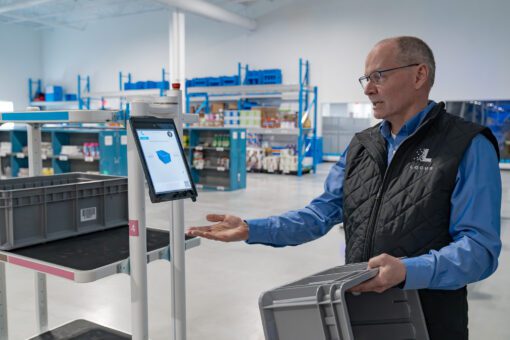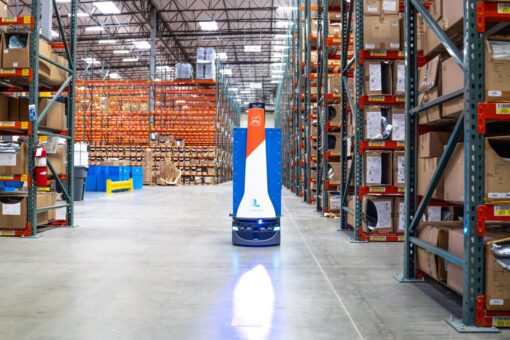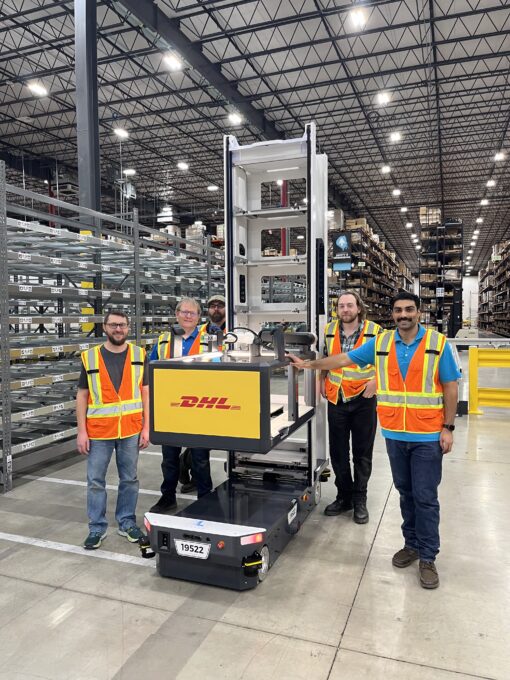WP: How to achieve 400 UPH with Locus Fast Pick
WP: How to achieve 400 UPH with Locus Fast Pick Download Now!
5 Ways Automation Optimizes Warehouse Operations
Bill Jozefowicz, Sr. Director of Continuous Improvement

Warehouses today face two significant challenges: labor shortages and complex inventory management. As workforce demographics shift, companies struggle to recruit, retain, and develop skilled labor. The competition for workers is fiercer than ever, making it increasingly difficult to ensure warehouses are adequately staffed, especially during peak seasons when demand spikes.
At the same time, inventory management has grown more complex. Consumers now expect same-day or next-day delivery, adding pressure to keep the right amount of inventory on hand. However, balancing stock levels with carrying costs is a constant struggle, particularly as demand becomes more unpredictable. Managing thousands of SKUs while ensuring real-time accuracy only adds to the challenge.
By automating key processes using modern warehouse automation technology, businesses can overcome these labor and inventory hurdles while significantly improving efficiency.
The Role of Warehouse Automation in Efficiency
Warehouse automation solutions reduces labor costs and also enhances warehouse efficiency. One of the most significant warehouse automation benefits is improved speed and throughput. Automated systems, such as autonomous robots and automated sorting and packing solutions, accelerate order fulfillment and help warehouses meet rising customer expectations.
Automation also reduces processing errors by replacing manual tasks with precise, repeatable processes, which leads to better order accuracy, fewer returns, and an overall improved customer experience. Additionally, automation minimizes human touchpoints, allowing for seamless data flow and reducing inefficiencies.
5 Ways Warehouse Automation Optimizes Operations
- Speed. In fast-paced distribution environments, speed is essential. Automation accelerates order picking, sorting, and packing, reducing fulfillment time. Autonomous robots work alongside employees to quickly retrieve and transport items, while automated conveyors and sorting systems eliminate bottlenecks to ensure continuous workflow.
- Flexibility. Unlike traditional fixed automation systems, Person-to-Goods (P2G) solutions provide unmatched flexibility without the high costs of Goods-to-Person (G2P) setups. These systems allow warehouses to scale operations dynamically, adapting to fluctuating demand without major infrastructure changes. This is particularly crucial in e-commerce, where demand can spike unpredictably.
- Labor Optimization. Warehouse automation reduces the physical strain on employees by handling repetitive, labor-intensive tasks. Instead of manually pulling heavy pick carts, workers can focus on higher-value activities such as quality control and exception handling. This not only boosts productivity but also improves workplace safety and employee satisfaction. During peak seasons, automation reduces reliance on temporary labor, lowering costs while maintaining efficiency.
- Inventory Accuracy. Real-time inventory tracking is one of the greatest advantages of warehouse automation. Automated systems provide precise, up-to-the-minute updates on stock levels, minimizing stockouts and overstocking. This ensures smoother operations and better customer satisfaction, as orders are consistently fulfilled on time.
- Throughput. By streamlining order processing, automation increases throughput without requiring additional labor. Robotic picking and sorting systems allow warehouses to handle a greater volume of orders efficiently, improving overall capacity management.
Preparing for Peak Season with Warehouse Automation
Peak seasons put immense pressure on warehouse operations. Warehouse automation technology helps scale operations without substantially increasing labor costs. These systems enhance order fulfillment by transporting goods quickly and efficiently, reducing reliance on seasonal workers. As a result, warehouses can meet demand spikes without major disruptions or excessive labor expenses.
Measuring Warehouse Automation Success: Key KPIs
To gauge the effectiveness of automation, warehouse leaders should track these key performance indicators (KPIs):
- Order Cycle Time: How quickly orders move from receiving to shipping.
- Hourly Throughput: The number of orders processed per hour, indicating efficiency gains.
- Productivity: How well labor and automation resources are utilized.
- Cost Per Unit of Processing: The financial impact of automation investments.
Many warehouse leaders focus on speed and labor cost reduction but often overlook critical factors such as ease of use, training requirements, and long-term scalability. Ensuring automation systems are user-friendly and adaptable is just as important as the initial investment. Additionally, leveraging data intelligence for operational improvements is key to long-term success.
Lessons from Real-World Warehouse Automation Success
A global footwear brand, Skechers, implemented AMRs in its California fulfillment center to address peak season challenges. The flexible autonomous robot system allowed the company to scale operations dynamically, increasing throughput without adding significant labor costs. By streamlining order picking and putaway processes, the company reduced fulfillment time, improved order accuracy, and enhanced customer satisfaction. The biggest wins? Greater operational agility and decreased reliance on temporary labor—highlighting the real-world benefits of warehouse automation.
Avoiding Common Warehouse Automation Pitfalls
Many companies make critical mistakes when implementing warehouse automation. Common missteps include:
- Failing to Engage Employees Early: Workers need to understand how automation benefits them. Without clear communication and proper training, adoption can be slow, leading to inefficiencies.
- Believing Automation Replaces Human Workers: Automation should complement human labor by allowing workers to focus on higher-value tasks and find other jobs with those tasks within the building.
- Relying on Intuition Instead of Data: Data-driven decision-making is crucial for optimizing warehouse efficiency. Leaders must leverage real-time analytics to make informed choices.
Mitigating Warehouse Automation Risks
While automation offers significant benefits, it also comes with challenges like high upfront costs, system integration complexity, and training requirements. However, companies can mitigate these risks by starting with scalable solutions, ensuring cross-functional buy-in, and prioritizing user-friendly technology. Choosing vendors with strong onboarding support can also ease transitions.
Smart, Intelligent Warehouse Automation
Over the next five years, “smart warehouses” will become the norm, integrating AI and machine learning for better demand forecasting, inventory management, and labor optimization. Flexible warehouse automation solutions will continue to evolve, allowing businesses to adapt quickly to market shifts without heavy capital expenditures.
For warehouses just starting their automation journey, the best advice is to choose a provider that understands their unique needs and offers scalable solutions. The goal isn’t just to automate individual tasks but to build a smart warehouse that is data-driven, agile, and continuously improving.
The biggest mindset shift for warehouse leaders regarding warehouse automation is moving from intuition-based decision-making to a data-driven approach. Historically, companies relied on increasing labor to boost throughput. By focusing on continuous improvement and leveraging automation’s full potential, warehouses can unlock long-term operational success.
Want to learn how to balance picking, packing, and inventory management in your warehouse for maximum efficiency? Let’s talk!
BIO:
Bill Jozefowicz is a seasoned supply chain executive with over 30 years of experience driving operational excellence, strategic growth, and transformative automation across logistics, e-commerce, and fulfillment industries. A recognized leader in supply chain innovation, he has a proven track record of delivering measurable improvements in efficiency, profitability, and customer satisfaction.
Jozefowicz leads one of the industry's top engineering teams in designing tailored solutions for autonomous robots at Locus Robotics. By gaining a deep understanding of each client’s business and taking a holistic view of their operations, his team seamlessly integrates the Locus solution to optimize warehouse workflows and enhance operational efficiency. His efforts have enabled global clients to streamline operations, reduce costs, and achieve scalable success in fast-paced and demanding supply chain environments.




